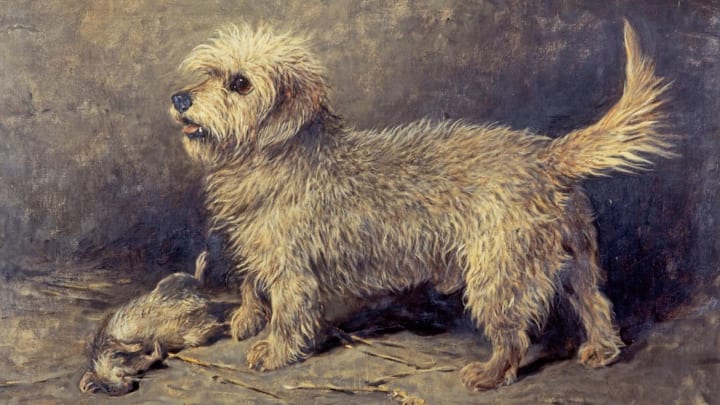Art galleries and museums build their collections in a number of different ways. One of these lies in the form of bequests that are left to the institutions after people’s deaths. People will donate artwork, objects, and even money that enables the institution of their choice to purchase more items. But sometimes, museums and galleries wind up receiving something odd—or something fairly normal, but with strange stipulations attached. Here’s a look at some unusual bequests that have been left to art galleries and museums over the past couple of centuries.
- James Smithson // Smithsonian Institution
- Francis Douce // Mysterious Box
- Henry Vaughan // J.M.W. Turner’s Paintings
- James Cowan Smith // His Dog’s Portrait
- Marcel Duchamp // Étant donnés
- Eli Leon // Nearly 3000 Quilts
James Smithson // Smithsonian Institution
The Smithsonian Institution was named after British chemist named James Smithson, the man who made its existence possible. Smithson didn’t have any kids to leave his fortune to, and decided that should his nephew die without fathering children, all of his wealth would instead go to the United States—despite the fact that he had never even visited the country. The gift was controversial at the time and a number of American figures allegedly resented Smithson’s patronage, particularly given the history between Britain and the U.S. But the bequest was ultimately accepted and the Smithsonian Institution institute continues to thrive today.
Francis Douce // Mysterious Box
Francis Douce was a curator at the British Museum in London for four years before resigning in 1811 due to a number of issues—all of which he detailed in an angry letter to the institution. Douce died in 1834 and left most of his papers to the Bodleian Library at the University of Oxford, but did ask that one box be given to the British Museum. That particular box came with an unusual stipulation: It could only be opened in 1900, which was 66 years after Douce’s death.
The museum’s trustees agreed to this strange condition. When the box was finally opened as stipulated, a number of contemporary newspaper reports stated it contained, among debris, a note saying Douce would never leave the museum anything of value (other accounts dispute the presence of a note). Whatever the contents, the former curator had the last laugh by making the museum wait so long to know what, if anything, was inside the box.
Henry Vaughan // J.M.W. Turner’s Paintings
The art collector Henry Vaughan was an avid admirer of the painter J.M.W. Turner. He collected many of the watercolor paintings the artist had created during his travels around Europe. After Vaughan’s death in 1899, the collector left a large number of bequests to art galleries in Britain and Ireland. He gave 31 watercolor paintings to the National Gallery of Ireland in Dublin and another 38 to the National Gallery in Edinburgh, but on the understanding that they only be publicly exhibited in January each year.
Vaughan thought the lack of strong light during this month would be the best conditions to prevent the colors in the paintings from fading. He also insisted that these January exhibitions be free of charge to the public; both galleries continue to honor this, with free annual “Turner in January” exhibitions still held in Dublin and Edinburgh.
James Cowan Smith // His Dog’s Portrait
In 1919, the National Gallery in Edinburgh received unexpected news when they learned that a wealthy engineer and philanthropist named James Cowan Smith had left them a very generous bequest: £52,257, the equivalent of around £2 million (almost $2.5 million) today, which was to be used to purchase artwork for its collections. The bequest had two conditions that were related to Cowan Smith’s dogs (both Dandie Dinmont terriers): one was that a sum of money be allocated to looking after his surviving dog, Fury, and the other that a portrait of his deceased dog, Callum, by the artist John Emms, be permanently hung on the walls. Callum’s portrait is still displayed at the gallery.
Marcel Duchamp // Étant donnés
Rather than donating someone else’s artwork, Marcel Duchamp left a piece he had created—but stipulated that it could only be unveiled after his death. Not only had the work never been seen before, but most people had no idea it even existed and wrongly thought Duchamp had abandoned art in his later years. Étant donnés, an installation that could only be viewed through eyeholes on a door, was his final work. Duchamp left detailed instructions on how his bequest was to be constructed and exhibited, with the secrecy and surprise acting as part of his final artistic statement. The Philadelphia Museum of Art acquired the piece and began displaying it in 1969, just one year after Duchamp died.
Eli Leon // Nearly 3000 Quilts
The writer Eli Leon left almost 3000 quilts made by Black quiltmakers to the Berkeley Art Museum and Pacific Film Archive in California after his death in 2018. Leon had helped to bring more attention to the creations of quiltmaker Rosie Lee Tompkins; he wanted to ensure this kind of work would be equally valued alongside other forms of art. The museum is due to host a new exhibition of them from June 7 to November 30, 2025.
Read More About Art:
